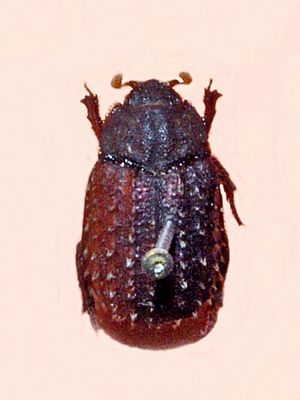Trox hispidus facts for kids
Quick facts for kids Trox hispidus |
|
|---|---|
 |
|
| Trox hispidus. Museum specimen | |
| Scientific classification | |
| Synonyms | |
|
The Trox hispidus is a type of beetle that belongs to the Trogidae family. These interesting insects are sometimes called "hide beetles" or "skin beetles" because of what they eat. They are known for their rough, bumpy appearance and their unique habitats.
Contents
What is a Trox Hispidus Beetle?
Trox hispidus is a specific kind of beetle. It was first described by a scientist named Erik Pontoppidan in 1763. These beetles are quite small and have a very distinct look that helps them blend into their surroundings.
Different Types of Trox Hispidus
Just like some animals have different breeds, Trox hispidus has a few known variations, called subspecies. These are slightly different groups within the same species.
- Trox hispidus hispidus (Pontoppidan, 1763)
- Trox hispidus mixtus (Harold, 1872)
Appearance of the Trox Hispidus
These beetles are not very big. They usually grow to be about 9–11 millimetres (0.35–0.43 in) long. That's less than half an inch!
Rough and Ready Skin
The top part of the Trox hispidus body is very bumpy and rough. It has ridges and small bumps, called tubercles. This rough texture helps them camouflage, or hide, in their environment. Their color is usually a dark brown.
Hairy Legs and Body
If you look closely, you'll see that their bodies and legs are covered in pale yellowish-white bristles. These tiny hairs give them a somewhat fuzzy look and might help them collect bits of their food or surroundings.
Where Trox Hispidus Lives
Trox hispidus beetles can be found in many parts of Europe. They are considered quite rare, meaning you don't see them very often.
Finding Them in Bird Nests
One of the most interesting places to find these beetles is in the nests of birds of prey. Birds of prey are birds like eagles, hawks, and owls. Trox hispidus beetles are scavengers, meaning they eat dead things. In bird nests, they might feed on leftover bits of food, feathers, or other organic material. This helps keep the nests clean!
See also
 In Spanish: Trox hispidus para niños
In Spanish: Trox hispidus para niños

